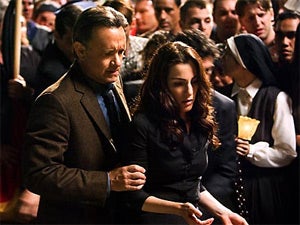Angels & Demons - Separating science from fiction
CERN scientist Tara Shears examines the scientific reality of new film Angels and Demons

Anti-matter and CERN are getting fantastic exposure with the release of the film Angels and Demons today - a film adaptation of Dan Brown’s novel of the same name.
As a CERN scientist myself, when I heard that part of the plot was based in the world’s biggest particle physics laboratory I was intrigued to see how our work would be portrayed. I was pleasantly surprised on the whole; it was wonderful to see particle physics get the Hollywood treatment! However, when you delve deeper into the science behind the plot, there is a line to draw between reality and fiction.
In the film, Tom Hanks plays the Harvard academic Robert Langdon, who finds evidence that an ancient clandestine brotherhood have stolen antimatter from a secret laboratory at CERN, which they plan to use as a weapon to destroy the Vatican. Langdon and CERN scientist Vittoria Vetra then try to recover the antimatter to prevent catastrophe.
Well firstly, the research we do is no secret – in fact we are thrilled at any opportunity to share our work, and our results are freely available to everyone. CERN hosts the Large Hadron Collider - a particle accelerator used by physicists to study the smallest known particles – and are helping make discoveries that benefit industry, medicine, and other numerous other fields. For example, both scanning and web technologies have developed from research conducted at CERN.
The second big flaw in the film’s plot focuses around the existence of anti-matter and its use as a bomb. It is indeed true that antimatter exists, and that matter and antimatter annihilate on contact. Just one gramme of antimatter annihiliating with one gramme of matter would have the explosive force of 20 000 tonnes of TNT. So in theory, large scale annihilation of antimatter and matter could indeed be used in a destructive way, as the film depicts. However, in reality CERN scientists have only ever made enough antimatter to power a light bulb for a few minutes, and we’re far too interested in using what little antimatter we’ve got to investigate the laws of nature instead.
It would take over a hundred million years to make the amount portrayed in the film, and even if we could it would certainly not be used destructively. What’s more, even if it was created it couldn’t be transported, as the antimatter traps needed to contain any significant quantity of antimatter would have to be vast. In other words, this is where fiction has overtaken technology.
So, although the film blurs the line between reality and fiction, it does give us at CERN a fantastic opportunity to get people talking about the science involved in all aspects of our lives. It may not get you signing up to a PhD in particle physics – but it will hopefully at least whet your appetite to find out more.
The question of why there seems to be so little anti-matter in the universe today, when we think that half of the universe was made of it in the Big Bang, is one of the biggest mysteries in science. You might think that antimatter is science fiction, but it played a crucial role in making our universe the way it is – and the LHCb and ALPHA experiments at CERN are working hard to understand more about it.
Tara is an ambassador of the Science: So What? So Everything campaign which aims to encourage people to understand the science behind different aspects of their lives, including the science featured in the films they watch. For more information on the campaign visit www.direct.gov.uk/sciencesowhat
Subscribe to Independent Premium to bookmark this article
Want to bookmark your favourite articles and stories to read or reference later? Start your Independent Premium subscription today.

Join our commenting forum
Join thought-provoking conversations, follow other Independent readers and see their replies